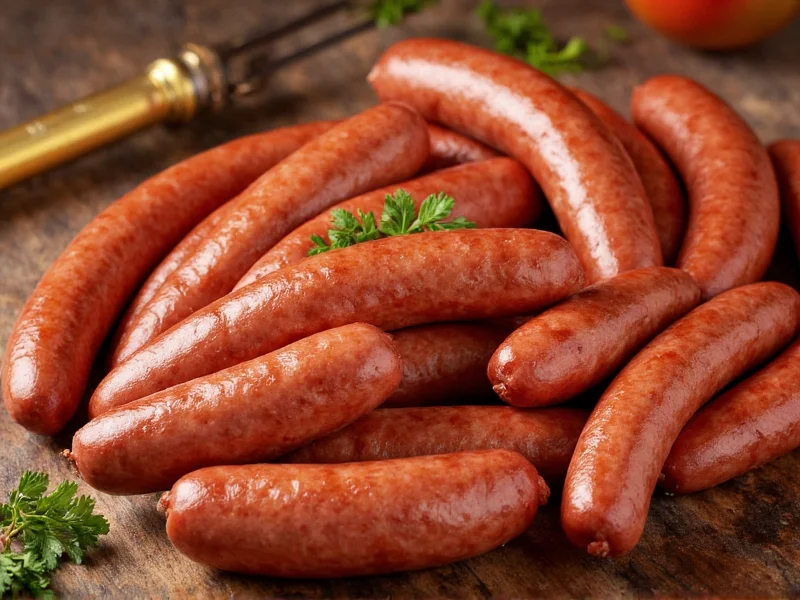These beloved components of Irish cuisine have evolved from practical resourcefulness to culinary staples. Historically, Irish sausages developed as a way to stretch limited meat supplies with affordable fillers like breadcrumbs, making them economical for everyday meals. The term "bangers" emerged during World War I when meat shortages led to increased water content in sausages, causing them to pop or "bang" when fried.
The Distinctive Characteristics of Authentic Irish Sausages
What truly sets Irish sausages apart isn't just their ingredients but their specific preparation methods passed down through generations. Traditional Irish sausage makers prioritize coarsely ground pork shoulder with a precise 70% meat to 30% filler ratio, creating that distinctive juicy yet firm texture. The seasoning remains deliberately simple—primarily sage with subtle notes of thyme, mace, and white pepper—allowing the pork flavor to shine through without overpowering spices common in other sausage varieties.
Unlike their German or Italian counterparts that feature bold garlic or wine infusions, Irish sausages maintain a delicate balance that complements rather than dominates accompanying dishes. This subtlety makes them exceptionally versatile in both traditional and modern cooking applications, from the classic full Irish breakfast to contemporary fusion recipes.
Traditional Ingredients and Preparation Methods
The foundation of authentic Irish sausages begins with high-quality pork, preferably from heritage breeds raised on Irish farms. Butchers typically use a combination of pork shoulder and belly to achieve the ideal fat content (approximately 25%), crucial for moisture and flavor. The distinctive texture comes from rusk—a dried, milled bread product—or fresh breadcrumbs, which absorb juices during cooking while preventing the sausage from becoming greasy.
Traditional preparation involves hand-mincing the pork to maintain texture, then carefully mixing with seasonings and binders. The mixture is stuffed into natural casings (usually pork or sheep intestine) and twisted into links of consistent size. Unlike mass-produced varieties, authentic Irish sausages avoid artificial preservatives, relying instead on proper handling and fresh preparation.
| Characteristic | Irish Sausages | English Sausages | German Bratwurst |
|---|---|---|---|
| Primary Meat | Pork | Pork | Pork/Veal |
| Key Seasoning | Sage | Sage, Thyme | Marjoram, Ginger |
| Filler Content | 25-30% rusk/breadcrumbs | 15-25% breadcrumbs | Minimal |
| Fat Content | 20-25% | 15-20% | 25-30% |
| Cooking Method | Fried or grilled | Fried or grilled | Pan-fried or grilled |
Regional Variations Across Ireland
While often considered a single category, Irish sausages actually feature notable regional differences that reflect local traditions and available ingredients. In Ulster, sausages tend to be slightly spicier with added black pepper, reflecting historical Scottish influences. Munster varieties often incorporate a touch of nutmeg, while Connacht sausages traditionally use a higher proportion of rusk for a lighter texture.
The breakfast sausage remains the most common variety, but specialty butchers across Ireland create unique interpretations for specific occasions. Some coastal regions incorporate subtle seafood elements in specialty sausages, while mountainous areas might feature game meats blended with pork in seasonal varieties. These regional distinctions showcase Ireland's diverse culinary landscape while maintaining the essential characteristics that define Irish sausages.
Traditional Cooking Methods and Pairings
Mastering the art of cooking Irish sausages requires understanding their unique composition. Due to their higher breadcrumb content, they need gentler heat than many sausage varieties to prevent the exterior from burning before the interior cooks through. The traditional method involves starting them in a cold pan with minimal fat, allowing gradual rendering of the pork fat to create a natural cooking medium.
For optimal results when preparing traditional Irish sausages at home, follow these professional tips:
- Never prick Irish sausages before cooking—they don't require it due to their composition
- Cook over medium-low heat for 15-20 minutes, turning regularly
- Allow sausages to rest for 5 minutes after cooking for juicier results
- Pair with traditional Irish brown sauce rather than ketchup for authentic flavor
The classic full Irish breakfast features sausages alongside bacon, black and white pudding, eggs, tomatoes, and mushrooms. However, modern Irish chefs increasingly incorporate them into innovative dishes like sausage and cabbage pot pies, creamy sausage stews, and even gourmet sausage rolls with artisanal fillings.
Common Misconceptions About Irish Sausages
Several persistent myths surround Irish sausages that deserve clarification. First, authentic Irish sausages contain no blood—that's black pudding, a completely different product. Second, while often called "bangers," this term refers to any sausage that pops during cooking, not specifically Irish varieties. Third, traditional Irish sausages contain minimal spices compared to their English counterparts, which often feature more complex herb blends.
Another frequent confusion involves American "Irish sausages," which often bear little resemblance to authentic Irish varieties. Many US products labeled as Irish sausages incorporate ingredients like garlic, wine, or cheese that would never appear in traditional Irish recipes. True Irish sausages maintain simplicity, letting quality pork and subtle seasoning shine through.
Preserving Authentic Irish Sausage Traditions
As industrial food production grows, preserving traditional Irish sausage-making methods has become increasingly important. Many small Irish butchers now emphasize heritage recipes and locally sourced ingredients to maintain authenticity. The Slow Food movement in Ireland has helped revive interest in traditional sausage varieties that were nearly lost to mass production.
When seeking authentic Irish sausages, look for butchers who use natural casings, avoid artificial preservatives, and maintain the traditional meat-to-binder ratio. The best varieties will have a slightly coarse texture when cut open, showing visible pieces of pork rather than the homogeneous mixture found in many commercial products.











 浙公网安备
33010002000092号
浙公网安备
33010002000092号 浙B2-20120091-4
浙B2-20120091-4